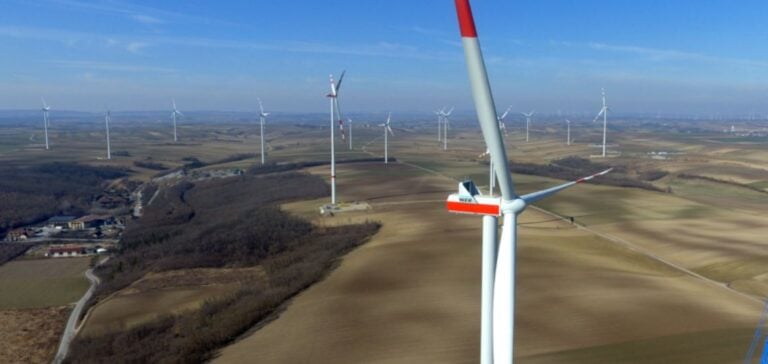The European Investment Bank (EIB) is financing a wind power development project in Austria with a €20.1 million loan to WEB Windenergie AG (W.E.B).
The financing will be used to launch the first construction phase of a wind farm in the Lower Austrian municipality of Spannberg.
The project will initially involve the installation of four wind turbines, followed by a further seven by 2027/2028.
Once completed, the wind farm will have a total capacity of 62 MW, supplying electricity to around 40,000 households, in line with Austria’s energy transition objectives.
Financial Management and Production Objectives
The ISB, as the main lender for this project, is covering 50% of the costs of the first construction phase.
The total cost of the project, which involves the installation of 11 turbines, is estimated at 115 million euros.
The turbines will be supplied by Vestas, a well-known European manufacturer in the sector.
This project illustrates ISB’s wider strategy to finance initiatives that reduce Europe’s dependence on fossil fuels, while supporting the development of renewable energy infrastructure.
The first four turbines should be connected to the grid within a year.
Each of these turbines, measuring almost 150 metres in height excluding the blades, will power around 3,800 homes.
The initiative is also in line with Europe’s REPowerEU objective, aimed at boosting energy security by diversifying clean energy supply sources.
The EIB plans to invest a further 45 billion euros in this plan by 2027.
Austria’s regulatory and energy context
Austria passed the Renewable Energy Expansion Act in 2021, setting an ambitious target of covering 100% of the country’s electricity needs with renewable sources by 2030.
Lower Austria, where Spannberg is located, has also introduced measures to simplify authorization procedures for renewable energy projects.
These efforts are aimed at reducing project lead times and stimulating investment in the energy sector.
By supporting projects like Spannberg, the EIB is playing a central role in accelerating Austria’s energy transition.
EIB financing is not limited to wind power alone; it covers a wide range of energy infrastructures, including solar and hydroelectric power, enabling a diversification of energy sources.
Impact on the energy market and European strategy
The Spannberg project is not only relevant to Austria, but is also part of a wider European dynamic.
By diversifying energy sources and promoting local projects, the European Union is seeking to limit its dependence on energy imports, particularly in the face of uncertain geopolitical conditions.
The EIB’s financing of this wind power project supports this strategy and ensures greater resilience of electricity grids.
WEB Windenergie AG, as developer, already has significant experience in managing wind farms and other renewable energy projects in Austria and internationally.
However, the focus of this article is on the financial and strategic dimension of the project.
The collaboration with EIB strengthens W.E.B’s strategic position in the European renewable energy market.
Political and economic issues
The EIB’s support for projects like Spannberg is also part of an industrial policy approach aimed at supporting technological innovation in Europe.
By investing in clean energy infrastructure projects, the EIB contributes to the competitiveness of Europe’s energy sector, while addressing climate and economic imperatives.
This policy is crucial in the current context of energy transition, where energy costs and security of supply are major concerns.
The project also benefits from the alignment of Austrian national policies with the objectives of the European Union, particularly with regard to the decarbonization of the energy sector.
By stimulating high value-added projects in the renewable energies sector, the EIB is contributing to job creation and economic growth in the regions concerned.






















